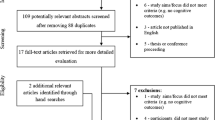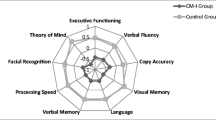Abstract
Purpose
Incidental cerebellar tonsillar ectopia (ICTE) that meets the radiographic criterion for Chiari malformation type I (CMI) is an increasingly common finding in the clinical setting, but its significance is unclear. The present study examined posterior cranial fossa (PCF) morphometrics and a broad range of health instruments of pediatric ICTE cases and matched controls extracted from the Adolescent Brain Cognitive Development (ABCD) dataset.
Methods
One-hundred-six subjects with ICTE and 106 matched controls without ICTE were identified from 11,411 anatomical MRI of healthy screened pediatric subjects from the ABCD project. Subjects were matched by sex, age, body mass index, race, and ethnicity. Twenty-two brain morphometrics and 22 health instruments were compared between the two groups to identify unrecognized CMI symptoms and assess the general health impact of ICTE.
Results
Twelve and 15 measures were significantly different between the ICTE and control groups for females and males, respectively. Notably, for females, the anterior CSF space was significantly smaller (p = 0.00005) for the ICTE group than controls. For males, the clivus bone length was significantly shorter (p = 0.0002) for the ICTE group compared to controls. No significant differences were found among the 22 health instruments between the two groups.
Conclusion
This study demonstrated that pediatric ICTE subjects have similar PCF morphometrics to adult CMI. ICTE alone did not appear to cause any unrecognized CMI symptoms and had no impact on the subjects’ current mental, physical, or behavioral health. Still, given their cranial and brain morphology, these cases may be at risk for adult-onset symptomatic CMI.

Similar content being viewed by others
References
Chiari C (2021) [cited 2021 23-Apr-2021]; Available from: https://chiari1000.uakron.edu/
Amin R et al (2015) The association between sleep-disordered breathing and magnetic resonance imaging findings in a pediatric cohort with Chiari 1 malformation. Can Respir J 22(1):31–36
Kumar A, Patni AH, Charbel F (2002) The Chiari I malformation and the neurotologist. Otol Neurotol 23(5):727–735
Sari SA, Ozum U (2021) The executive functions, intellectual capacity, and psychiatric disorders in adolescents with Chiari malformation type 1. Childs Nerv Syst
Tubbs RS et al (2011) Institutional experience with 500 cases of surgically treated pediatric Chiari malformation Type I. J Neurosurg Pediatr 7(3):248–256
Shaikh AG, Ghasia FF (2015) Neuro-ophthalmology of type 1 Chiari malformation. Expert Rev Ophthalmol 10(4):351–357
Lacy M et al (2016) Parent-reported executive dysfunction in children and adolescents with Chiari Malformation Type 1. Pediatr Neurosurg 51(5):236–243
Abel F, Tahir MZ (2019) Role of sleep study in children with Chiari malformation and sleep disordered breathing. Childs Nerv Syst 35(10):1763–1768
Simons JP, Ruscetta MN, Chi DH (2008) Sensorineural hearing impairment in children with Chiari I malformation. Ann Otol Rhinol Laryngol 117(6):443–447
Davidson L et al (2021) Long-term outcomes for children with an incidentally discovered Chiari malformation type 1: what is the clinical significance? Childs Nerv Syst 37(4):1191–1197
Whitson WJ et al (2015) A prospective natural history study of nonoperatively managed Chiari I malformation: does follow-up MRI surveillance alter surgical decision making? J Neurosurg Pediatr 16(2):159–166
Meadows J et al (2000) Asymptomatic Chiari Type I malformations identified on magnetic resonance imaging. J Neurosurg 92(6):920–926
O’Reilly EM, Torreggiani W (2019) Incidence of asymptomatic Chiari malformation. Ir Med J 112(7):972
Smith BW et al (2013) Distribution of cerebellar tonsil position: implications for understanding Chiari malformation. J Neurosurg 119(3):812–819
Jansen PR et al (2017) Incidental findings on brain imaging in the general pediatric population. N Engl J Med 377(16):1593–1595
Vernooij MW et al (2007) Incidental findings on brain MRI in the general population. N Engl J Med 357(18):1821–1828
Haroun RI et al (2000) Current opinions for the treatment of syringomyelia and chiari malformations: survey of the Pediatric Section of the American Association of Neurological Surgeons. Pediatr Neurosurg 33(6):311–317
Singhal A, Cheong A, Steinbok P (2018) International survey on the management of Chiari 1 malformation and syringomyelia: evolving worldwide opinions. Childs Nerv Syst 34(6):1177–1182
Benglis D Jr et al (2011) Outcomes in pediatric patients with Chiari malformation Type I followed up without surgery. J Neurosurg Pediatr 7(4):375–379
Leon TJ et al (2019) Patients with “benign” Chiari I malformations require surgical decompression at a low rate. J Neurosurg Pediatr 23(4):498–506
Strahle J et al (2011) Natural history of Chiari malformation Type I following decision for conservative treatment. J Neurosurg Pediatr 8(2):214–221
Chatrath A et al (2019) Chiari I malformation in children-the natural history. Childs Nerv Syst 35(10):1793–1799
Adolescent Brain Cognitive Development (ABCD) 2021 [cited 2021 02/24/2021]; Available from: https://abcdstudy.org/about/
Casey BJ et al (2018) The Adolescent Brain Cognitive Development (ABCD) study: imaging acquisition across 21 sites. Dev Cogn Neurosci 32:43–54
Barch DM et al (2018) Demographic, physical and mental health assessments in the adolescent brain and cognitive development study: rationale and description. Dev Cogn Neurosci 32:55–66
Garavan H et al (2018) Recruiting the ABCD sample: design considerations and procedures. Dev Cogn Neurosci 32:16–22
Michelini G et al (2019) Delineating and validating higher-order dimensions of psychopathology in the Adolescent Brain Cognitive Development (ABCD) study. Transl Psychiatry 9(1):261
Li Y, et al (2021) Rates of incidental findings in brain magnetic resonance imaging in children. JAMA Neurol
Nwotchouang BST, et al (2019) Three-dimensional CT morphometric image analysis of the clivus and sphenoid sinus in Chiari malformation Type I. Ann Biomed Eng
Eppelheimer MS et al (2019) Quantification of changes in brain morphology following posterior fossa decompression surgery in women treated for Chiari malformation type 1. Neuroradiology 61(9):1011–1022
Houston JR et al (2018) A morphometric assessment of type I Chiari malformation above the McRae line: a retrospective case-control study in 302 adult female subjects. J Neuroradiol 45(1):23–31
Furtado SV et al (2010) Morphometric analysis of foramen magnum dimensions and intracranial volume in pediatric Chiari I malformation. Acta Neurochir (Wien) 152(2):221–7; discussion 227
Khalsa SSS et al (2018) Morphometric and volumetric comparison of 102 children with symptomatic and asymptomatic Chiari malformation Type I. J Neurosurg Pediatr 21(1):65–71
Trigylidas T et al (2008) Posterior fossa dimension and volume estimates in pediatric patients with Chiari I malformations. Childs Nerv Syst 24(3):329–336
Eppelheimer MS et al (2018) A retrospective 2D morphometric analysis of adult female Chiari Type I patients with commonly reported and related conditions. Front Neuroanat 12:2
Biswas D et al (2019) Quantification of cerebellar crowding in Type I Chiari malformation. Ann Biomed Eng 47(3):731–743
Houston JR et al (2020) Evidence of neural microstructure abnormalities in Type I Chiari malformation: associations among fiber tract integrity, pain, and cognitive dysfunction. Pain Med 21(10):2323–2335
Nwotchouang BST et al (2020) Clivus length distinguishes between asymptomatic healthy controls and symptomatic adult women with Chiari malformation type I. Neuroradiology 62(11):1389–1400
Krishan K, Kanchan T (2013) Evaluation of spheno-occipital synchondrosis: a review of literature and considerations from forensic anthropologic point of view. J Forensic Dent Sci 5(2):72–76
Bassed RB, Briggs C, Drummer OH (2010) Analysis of time of closure of the spheno-occipital synchondrosis using computed tomography. Forensic Sci Int 200(1–3):161–164
Tiemeier H et al (2010) Cerebellum development during childhood and adolescence: a longitudinal morphometric MRI study. Neuroimage 49(1):63–70
Wilkinson DA et al (2017) Trends in surgical treatment of Chiari malformation Type I in the United States. J Neurosurg Pediatr 19(2):208–216
Greenberg JK et al (2015) Complications and resource use associated with surgery for Chiari malformation type 1 in adults: a population perspective. Neurosurgery 77(2):261–268
Marty P et al (2015) Gender-specific differences in adult type I Chiari malformation morphometrics (P4.174). 84(14 Supplement):P4.174
Goel A et al (2020) Chiari 1 formation redefined-clinical and radiographic observations in 388 surgically treated patients. World Neurosurg 141:e921–e934
Brill CB, Gutierrez J, Mishkin MM (1997) Chiari I malformation: association with seizures and developmental disabilities. J Child Neurol 12(2):101–106
Granata T, Valentini LG (2011) Epilepsy in type 1 Chiari malformation. Neurol Sci 32(Suppl 3):S303–S306
Stagi S et al (2004) Precocious, early and fast puberty in males with Chiari I malformation. J Pediatr Endocrinol Metab 17(8):1137–1140
Pucarelli I et al (2010) Precocious puberty in two girls with Chiari I malformation: a contribution to a larger use of brain MRI in the diagnosis of central precocious puberty. Minerva Pediatr 62(3):315–317
Bolognese PA et al (2019) Chiari I malformation: opinions on diagnostic trends and controversies from a panel of 63 international experts. World Neurosurgery 130:e9–e16
Sadler B et al (2020) Prevalence and Impact of Underlying Diagnosis and Comorbidities on Chiari 1 Malformation. Pediatr Neurol 106:32–37
Acknowledgements
Data used in the preparation of this article were obtained from the Adolescent Brain Cognitive Development (ABCD) Study (https://abcdstudy.org), held in the NIMH Data Archive (NDA). This is a multisite, longitudinal study designed to recruit more than 10,000 children age 9-10 and follow them over 10 years into early adulthood. The ABCD Study is supported by the National Institutes of Health and additional federal partners under award numbers U01DA041048, U01DA050989, U01DA051016, U01DA041022, U01DA051018, U01DA051037, U01DA050987, U01DA041174, U01DA041106, U01DA041117, U01DA041028, U01DA041134, U01DA050988, U01DA051039, U01DA041156, U01DA041025, U01DA041120, U01DA051038, U01DA041148, U01DA041093, U01DA041089, U24DA041123, U24DA041147. A full list of supporters is available at https://abcdstudy.org/federal-partners.html. A listing of participating sites and a complete listing of the study investigators can be found at https://abcdstudy.org/consortium_members/. ABCD consortium investigators designed and implemented the study and/or provided data but did not necessarily participate in analysis or writing of this report. This manuscript reflects the views of the authors and may not reflect the opinions or views of the NIH or ABCD consortium investigators.
The ABCD data repository grows and changes over time. The ABCD data used in this report came from the fast track data release. The raw data are available at https://nda.nih.gov/edit_collection.html?id=2573.
Funding
The study was funded by Conquer Chiari.
Author information
Authors and Affiliations
Corresponding author
Ethics declarations
Ethical approval
This study was approved by the local institutional review board at The University of Akron. All procedures performed in studies involving human participants were in accordance with the ethical standards of the institutional and/or national research committee and with the 1964 Helsinki declaration and its later amendments or comparable ethical standards. For this type of study formal consent is not required.
Informed consent
Informed consent was obtained from all individual participants included in the study.
Conflict of interest
Author Jayapalli Rajiv Bapuraj is a recipient of a research grant from Conquer Chiari.
Additional information
Publisher's note
Springer Nature remains neutral with regard to jurisdictional claims in published maps and institutional affiliations.
Supplementary Information
Below is the link to the electronic supplementary material.
Rights and permissions
About this article
Cite this article
Nwotchouang, B.S.T., Ibrahimy, A., Loth, D.M. et al. Imaging and health metrics in incidental cerebellar tonsillar ectopia: findings from the Adolescent Brain Cognitive Development Study (ABCD). Neuroradiology 63, 1913–1924 (2021). https://doi.org/10.1007/s00234-021-02759-y
Received:
Accepted:
Published:
Issue Date:
DOI: https://doi.org/10.1007/s00234-021-02759-y




